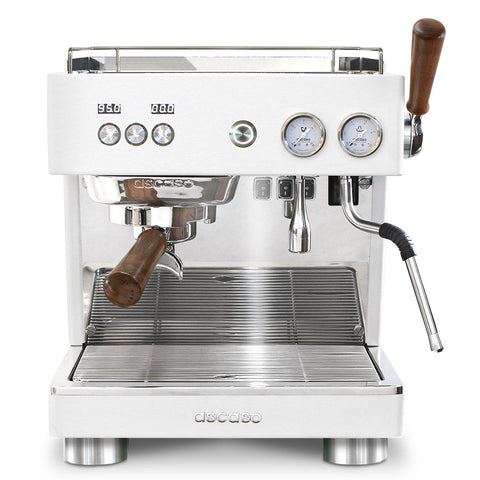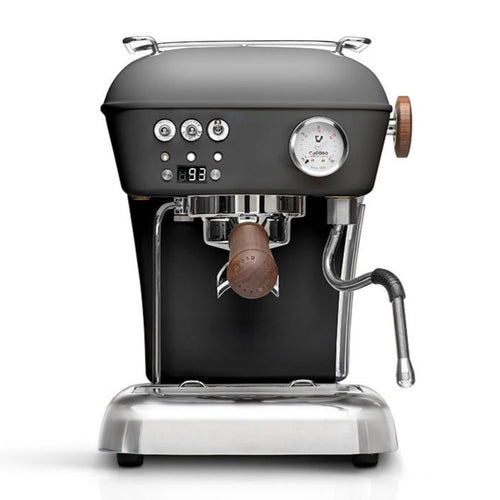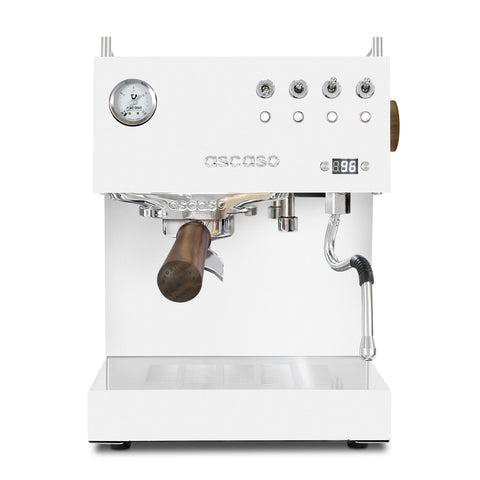Ascaso is a Spanish brand headquartered in Barcelona with over 60 years in the market and great expertise in commercial espresso machine parts and engines. Though Ascaso espresso machines are newer in North America, the brand has an established presence in other parts of the world.
Let’s explore the three sets of Ascaso espresso machine models, and which coffee service settings they work best in, to understand if this is the right brand for you.
In this article, you will:
- Get to know the different Ascaso prosumer and professional espresso machines
- Learn why Ascaso machines are environmentally friendly and help you save energy
- Learn how to choose the best Ascaso model according to your needs
Keep reading to learn about some Ascaso models in detail and get to know what a professional barista had to say.
An Overview of Ascaso’s Espresso Machine Models
Let’s break down some Ascaso models that are representative of the brand in every range.
Barista T Plus: Best for High-Volume Coffee Shops and Restaurants


The Barista T Plus is Ascaso’s answer to the high-volume cafe or restaurant that needs a workhorse espresso machine that can keep up during rushes.
An innovative multi-group technology, the T technology featured in the Ascaso T series means that programming and switching on/off can be separately controlled in each group. By programming each group head’s temperature and pre-infusion separately, you can offer multiple coffees as espresso, or use one coffee to make different types of espresso shots (a long pre-infusion lungo shot on one group, and a short pre-infusion ristretto on another, for example).
Being able to turn off unused groups during slow times allows lower energy consumption and more efficiency than other commercial espresso machine systems, because power will only be needed by the part of the machine you are using at a given time. Moreover, the heating element operates only for as long as it is needed.
The Barista T Plus model has 2 and 3 group versions. It includes an extra heating element for groups, steam and group boiler thermal insulation, steam joy-stick taps for better control, an anti-splash system, safety switches for each group, an active cup warmer, and wooden accessories, to make the most out of its functions.
All groups and the steam boiler have electronic PID control. This feature allows you to monitor and stabilize the temperature in the coffee machine, avoiding harsh fluctuations because you can raise the temperature in one-degree increments. It also has steam control, a coffee dose timer and programmable preinfusion, all with the help of an integrated display.
Baby T Plus: Best For Coffee Trucks, Carts, and Small Cafés that Want Premium Features
The prosumer version of the Barista T line of commercial espresso machines, the Ascaso Baby T Plus, offers the same features in a smaller one-group machine for a high-quality extraction in places where space is tight.
The Ascaso Baby T Plus model has a dynamic group pre-heating function and a stainless steel rotary pump that offers a constant amount of pressure—the smaller machine does not mean it is any less reliable.
The Baby T Plus uses an algorithm that guarantees thermal stability of the water at the entrance of each group, with maximum fluctuations of 0.5 °C. Having a constant water and temperature pressure allows a more uniform extraction of every shot, both for frequent and simultaneous use of more groups during rush hour and to pull a single shot when needed.
Ascaso Dream PID: Best for Home & Office Use
With its retro aesthetics and high-quality materials, the Ascaso Dream machines, designed in 2000 by Marc Aranyó, became the most representative of the brand and has been upgraded over the years.
The Ascaso Dream PID weighs only 22 lbs, with many colors to choose from to match your kitchen design.
Features added to the PID version of the Dream include an active cup warmer, volumetric control to measure your shots, a group thermal cover, a water tank light indicator and wooden accessories. Moreover, the Dream PID features a heat-resistant steam wand and adjustable OPV (over pressure valve) that enables brewing pressure regulation in the pump and prevents over-extraction by setting a maximum limit.
In addition to both a traditional and an ESE pod filter, Ascaso Dream also features a pressurized “super-froth” filter, that allows you to pull extra-frothy espresso shots, no matter which coffee you are using.
Ascaso Steel DUO: Best for Lower-Volume Coffee Trucks, Carts, and Popups
Ascaso’s Steel range is composed of prosumer machines suitable for both office, home, and low-volume coffee cart use.
They are made of durable materials, such as Steel, as their name says, aluminum, brass and minimize the use of plastic. Different from the UNO version, Ascaso Steel DUO has separate boilers for coffee and steam, so you can pull shots and steam milk at the same time without ever dropping pressure. It also has an optional PID version, which is helpful for monitoring boiler temperature during peak times.
A Professional Barista’s Thoughts on Ascaso Machines
David Quintero is the barista and co-owner of Craneo Sacral, a specialty coffee truck in Bogotá, Colombia. He spoke with us about his experience with an Ascaso Steel DUO PID, what to expect from the machine, how he uses its features, and why it is suitable for learning.
Why did you choose the Ascaso Steel Duo PID?
“We chose the DUO PID model because it is a very compact machine, and it has independent thermoblocks. It has an elegant and minimalist design and its size is suited for our operations because our café is as big as a truck”.
Was it difficult to learn how to use it the first time?
“Given that it is a relatively new technology, it has many functions, but the user manual is very clear, complete, and easy to understand. It wasn’t very difficult to understand how the machine works.”
What features have been more useful for your work and why?
“The features that allow us to work in an optimal way are, in the first place, that it allows us to regulate the temperature based on the coffees that we get. We can lower it down to 80℃ or turn it up to 120 ℃. This enables us to work with very fresh coffees that haven’t been roasted since very long, so, by lowering the temperature, we can better manage the volatile gasses in recently roasted coffees.”
“On the other hand, the machine has a calibration system that measures the drink volume, but not the extraction time. In this way, we obtain a very consistent espresso during the whole day, without having to calibrate 2 or 3 times in a day.”
“We can also make preinfusions for up to 5 seconds, which is very useful because the water passes through the coffee puck without pressure, and this allows to better open the coffee particles and obtain a more uniform extraction, something very important when you brew filter coffee. In older boiler coffee machines this is not possible, so we can play with it.”
How often does it need maintenance? Which things can you do without the help of a technician?
“Maintenance is very simple. It has an automatic washing system, so we can do it ourselves by using a cleaning product like Cafiza and a steam wand detergent. However, for software-related issues, a technician is necessary, although many issues of this type can be solved by checking the user manual”.
Can you describe some of the common problems you’ve experienced with this machine?
“We haven’t had issues. As long as there is a reliable energy source, the machine will work perfectly. If you use it in a place without a three-phase system, like ours, it will be a concern, because it requires a 40 Amps peak to switch on. We had to install a stabilizer, in case the machine needs a constant amount of energy.”
In combination with a quality grinder, how does the espresso pulled, the milk steamed and the quality of beverages prepared with this machine compare to others you’ve used throughout your career?
“For our espresso shots, we break a bit the rules of espresso for the coffee and water ratio. We can make them a bit longer without sacrificing either crema not flavor. Together with the temperature regulation and preinfusion features, we can better leverage espressos that are sweeter and less intense, more friendly to the average Colombian palate, but keeping the characteristics of the espresso. We do it to be more efficient with our work, as we pull double shots to keep up with the demand in the café.”
“The steam wand is very interesting: it only has one hole. This concentrates pressure and makes steaming the milk a lot easier, so it is very suitable for learning. It also has a heat isolation tube inside, reducing the risk of burning the barista! Something that often happens with conventional espresso machines.”
What can you say about energy consumption?
We chose it because it is environmentally friendly. It consumes half the energy than conventional dual boiler espresso machines of one or more groups.
So, What’s the Best Ascaso Espresso Machine?
The answer depends on how you want to use it. Here is a summary:
|
Machine |
Best for |
|
Coffee shops with a high volume of customers |
|
|
Coffee shops, restaurants |
|
|
Coffee trucks, carts, and popups that want premium features but are low on space |
|
|
Home & office use |
|
|
Home & office use |
|
|
Lower-Volume Coffee Trucks, Carts, and Popups |
Overall, Ascaso machines are ideal for café owners and baristas that:
- Are opening their first coffee shop or have a reduced budget but still want a high performing espresso machine.
- Want to learn the basics of espresso and milk steaming. They are suitable for learners and less experienced baristas and offer the possibility to experiment with many variables.
- Expect to deliver high quality, good tasting espressos and other beverages.
Thinking about getting an Ascaso machine? Check out our available models and contact us! We can help you find the best model for your needs.









